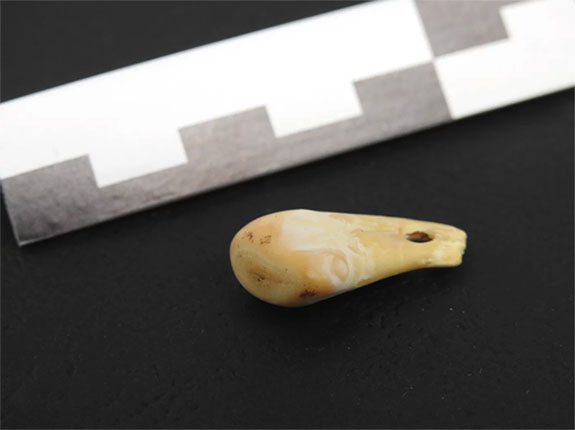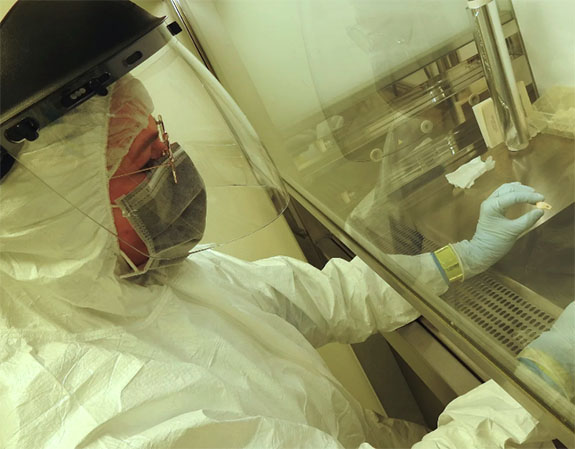
Music Friday: ‘Promise Ring’ Protects This Couple From ‘The Bitter Tide’
Welcome to Music Friday when we bring you awesome songs with jewelry, gemstones or precious metals in the title or lyrics. Today, former Tremolo frontman
For the first time, scientists have devised a way to successfully extract human DNA from an ancient artifact — in this case, a 20,000-year-old deer-tooth pendant discovered in the famous Denisova Cave in southern Siberia.

The DNA extraction technique, which has been described as a non-destructive, high-temperature “washing machine,” will make it possible to identify the biological sex and genetic heritage of the person who previously used or wore the item.
The breakthrough is credited to an international research team led by the Max Planck Institute for Evolutionary Anthropology (MPI) in Leipzig, Germany.
The team was able to determine that the deer tooth pendant was likely worn by a woman to lived between 19,000 and 25,000 years ago and was closely related to contemporaneous ancient individuals from further east in Siberia, the so called “Ancient North Eurasians.”

The scientists explained that the woman’s DNA had been transferred to the porous tooth pendant via skin cells or sweat. From the DNA retrieved they were able to reconstruct a precise genetic profile of the woman who used or wore the pendant, as well as of the deer from which the tooth was taken.
“For the first time, we can link an object to individuals,” Marie Soressi, an archaeologist from the University of Leiden, told newscientist.com. “So, for example, were bone needles made and used by only women, or also men? Were those bone-tipped spears made and used only by men, or also by women? With this new technique, we can finally start talking about that and investigating the roles of individuals according to their biological sex or their genetic identity and family relationships.”
What’s amazing about the new DNA extraction technique is that it leaves the specimen fully intact.
The team tested the influence of various chemicals on the surface structure of archaeological bone and tooth pieces and developed a non-destructive phosphate-based method for DNA extraction.
“One could say we have created a washing machine for ancient artifacts within our clean laboratory,” explained Elena Essel, who developed the method and is the lead author of the study. “By washing the artifacts at temperatures of up to 90°C (194°F), we are able to extract DNA from the wash waters, while keeping the artifacts intact.”
In testing their methods, the MPI team had to overcome some frustration hurdles. For one, the artifacts had to be untouched by modern researchers, otherwise their own DNA would be on the items.
To overcome the problem of modern human contamination, the researchers focused on material that had been freshly excavated using gloves and face masks and put into clean plastic bags with sediment still attached, according to an MPI press release.
The breakthrough occurred when Maxim Kozlikin and Michael Shunkov — archaeologists excavating the famous Denisova Cave in Russia — cleanly excavated and set aside an Upper Paleolithic deer tooth pendant.
Utilizing that pristine artifact, the geneticists in Leipzig isolated not only the DNA from the animal itself, a wapiti deer, but also large quantities of ancient human DNA.
“Forensic scientists will not be surprised that human DNA can be isolated from an object that has been handled a lot,” said Max Planck geneticist Matthias Meyer, “but it is amazing that this is still possible after 20,000 years.”
Credits: Images courtesy of © MPI for Evolutionary Anthropology.

Welcome to Music Friday when we bring you awesome songs with jewelry, gemstones or precious metals in the title or lyrics. Today, former Tremolo frontman

If your travels take you through southern New England this summer, be sure to stop into the Yale Peabody Museum, which officially reopened its Halls

A mother-daughter duo sauntering through London’s Crystal Palace Park during an outdoor taping of BBC’s Antiques Roadshow were shocked to learn that a diamond ring

In 1885, Russian Tsar Alexander III commissioned the House of Fabergé to create a fabulous Easter egg for his wife, the Empress Maria Feodorovna. The






📅 Experience elegance and history at Elliott's Jewelers Estate Jewelry Event, August 22-24! Explore timeless pieces ready to tell their next story. Preview and select your favorites (like this dazzling ring) here: www.elliottsjewelers.com/from-the-vault/#categories& and book a private appointment to see them in person. Your journey through time awaits! ✨
Call Elliott's Jewelers today at (936) 661-5363 or book an appointment online www.elliottsjewelers.com/book-an-appointment/
Browse our shop online at www.elliottsjewelers.com/ ... See MoreSee Less
0 CommentsComment on Facebook
Great event. Thank you Huntsville ... See MoreSee Less
0 CommentsComment on Facebook
💎 Step back in time with Elliott's Jewelers at our August Estate Jewelry Event! From August 22nd to 24th, explore exquisite, historical pieces from our collection. Preview our treasures here: www.elliottsjewelers.com/from-the-vault/#categories& and reserve your private viewing appointment between 9:30 am and 5:00 pm. Don’t miss your chance to own a piece of history! 👑 🕰️
Call Elliott's Jewelers today at (936) 661-5363 or book an appointment online www.elliottsjewelers.com/book-an-appointment/
Browse our shop online at www.elliottsjewelers.com/ ... See MoreSee Less
0 CommentsComment on Facebook
Picture this: an 'Anniversary Diamond' that sparkles with brilliance and the memories of years together. Why not consider upgrading the diamond in your wedding ring this upcoming milestone anniversary?
It's a beautiful way to renew your commitment and add an extra chapter to your love story. 💖💍
We carry ONLY Natural Gemological Institute of America Certified diamonds. All shapes and sizes are available. All colors and clarities.
1.00 carat and larger diamonds are our specialty. Set your new diamond in some of our most beautiful and unique settings or custom design your dream ring.
Call Elliott's Jewelers today at (936) 661-5363 or book an appointment online: www.elliottsjewelers.com/book-an-appointment/
Browse online at www.elliottsjewelers.com/shop/ ... See MoreSee Less
This content isn't available right now
When this happens, it's usually because the owner only shared it with a small group of people, changed who can see it or it's been deleted.0 CommentsComment on Facebook
Mark your milestone anniversary with a special upgrade from Elliott's Jewelers.💕 Can I make this ring for you?
As your love grows, so should your diamond. Let us craft a custom ring that celebrates your journey together. Start your timeless upgrade today.💍✨
Call Elliott's Jewelers today at (936) 661-5363 or book an appointment online www.elliottsjewelers.com/book-an-appointment/
Browse our shop online at www.elliottsjewelers.com/ ... See MoreSee Less
Shop Now
5 CommentsComment on Facebook
That is a very beautiful ring! What would something like this cost?
That’s a Beautiful ring WOW!
I no longer have anniversary’s, but it’s very pretty. Thanks for sharing. JS
View more comments
🌟 Uncover the history and beauty of estate jewelry at Elliott's Jewelers this August! Join us for our exclusive Estate Jewelry Event from August 22nd-24th. Dive into our vault here: www.elliottsjewelers.com/from-the-vault/#categories& and select pieces to view at your private appointment. Book now to secure a spot from 9:30 am to 5:00 pm each day and make history part of your style! 🕰️✨
Call Elliott's Jewelers today at (936) 661-5363 or book an appointment online www.elliottsjewelers.com/book-an-appointment/ Browse online at www.elliottsjewelers.com/shop/ ... See MoreSee Less
0 CommentsComment on Facebook
Make your old jewelry work for you! 🌟 At Elliott's Jewelers, every piece holds value. Trade in your unworn treasures for funds or upgrade to something new and sparkling. Refresh your collection today. See how far your jewelry can take you with us! 💍 Find out more: www.elliottsjewelers.com/sell-your-jewelry/
Call Elliott's Jewelers today at (936) 661-5363 or book an appointment online www.elliottsjewelers.com/book-an-appointment/ Browse online at www.elliottsjewelers.com/shop/ ... See MoreSee Less
Learn More
Book an Appointment - Elliott's Jewelers
www.elliottsjewelers.com
Book an Appointment At Elliott’s Jewelers, you can be sure that you are getting the best possible appraisal for your jewelry. Our jewelry experts are trained and certified in jewelry appraisal, and ...1 CommentComment on Facebook
I have sent you pictures twice but never received a response.
🌟 Step into a world of timeless elegance with our August Estate Jewelry Event at Elliott's Jewelers! 📅 Mark your calendars: August 22nd-24th. Immerse yourself in the stories of exquisite pieces from our vault. To make this experience truly personal, we are scheduling exclusive appointments from 9:30 am to 5:00 pm each day.
Spaces are limited to ensure privacy and dedicated attention. 🕒 Book your appointment now and let us help you find a piece that not only enhances your collection but enriches your story.
Call Elliott's Jewelers today at (936) 661-5363 or book an appointment online www.elliottsjewelers.com/book-an-appointment/ ... See MoreSee Less
1 CommentComment on Facebook
Gorgeous
💎 Discover timeless treasures at our August Estate Jewelry Event! Join us from August 22nd-24th at Elliott's Jewelers. Each piece has a unique story waiting to be part of yours.
Explore our exclusive collection here and book your private appointment from 9:30 am to 5:00 pm daily. Spaces are limited to ensure personalized attention. ✨ Find your next jewel with us! See more here: www.elliottsjewelers.com/from-the-vault/#categories&
Call Elliott's Jewelers today at (936) 661-5363 or book an appointment online www.elliottsjewelers.com/book-an-appointment/ ... See MoreSee Less
1 CommentComment on Facebook
Very pretty.
Elliott’s Jewelers Huntsville,TX www.elliottsjewelers.com ... See MoreSee Less
0 CommentsComment on Facebook
Photos from Huntsville Independent School District's post ... See MoreSee Less
4 CommentsComment on Facebook
Beautiful 😍
Well done!
Thank you so much for your support & for such a beautiful piece!
Elliott's Jewelers wishes you and your family a Happy 4th of July! We will be closed on Thursday, July 4th. Elliott's Jewelers was thrilled to be part of Mitch and Lauren Fussell's love story. Do you have an Elliott's Jewelers story too? Let's celebrate by sharing it with us so we can continue making history together! Your stories inspire us every day. 🎆
Share Your Elliott's Jewelers Story: www.elliottsjewelers.com/share-your-story/ ... See MoreSee Less
1 CommentComment on Facebook
Wish I could click the “Love” and “Wow” Buttons at the same time.